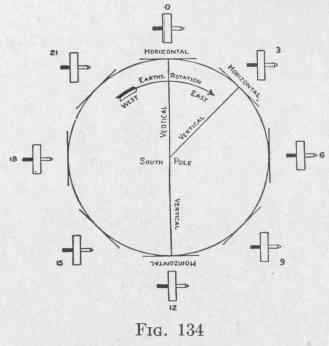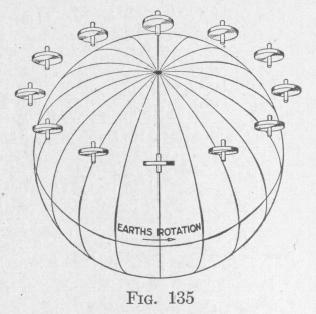172 NAVIGATIONAL COMPASSES
face inclined to the horizontal at the proper angle and the clock with the attached disk turned with respect to the lubber line through an angle equal to that of the desired course from the meridian. Then, the proper course is maintained by steering
the airplane or ship so that the shadow of the shadowpin is maintained along the axis of the clock hand.
When the course is not exactly north or south, the apparent time changes. In this case either the clock may be reset after each change of a few degrees longitude, or it may be set permanently to the apparent time of the middle meridian.
105. The Apparent Motion of the Spin-Axle of an Un
constrained Gyroscope Due to the Rotation of the Earth. - According to the First Law of Gyrodynamics (Art. 36), the spin-axle of an unconstrained spinning gyro, unacted upon by any torque, remains fixed in space. This law is also called the law of rigidity
of plane of the gyro, or the law
of the fixity in space of the spin-axle. If the gyro-axle of a spinning gyro at the equator is parallel to the geographic axis of the earth, then the axle will remain horizontal and in the meridian plane. If the gyroaxle of a spinning gyro at the equator is horizontal in the east-west position, as at 0, Fig. 134, then, although the gyroaxle preserves its direction in
space as the earth rotates, it appears to an observer on the earth to make one complete turn each twenty-four hours about the horizontal axis in the meridian plane.
If an unconstrained spinning gyro be situated between the equator and either pole, then the spin-axle will appear to an ob
THE VARIOUS TYPES 173
server on the earth to move about both a horizontal and a vertical axis, Fig. 135. At two times during twenty-four hours, the gyroaxle is horizontal and at two times it is in the meridian plane. The motion of the spin-axle relative to the earth is about a cone having the center of the gyro as apex.
The spin-axle of an unconstrained gyroscope continues to be directed toward the same fixed star but it does not continue to be directed toward the same fixed point on the earth. The fixity of the spin-axle in space of an unconstrained gyroscope is inadequate for the production of an instrument that will indicate directions on the earth.
106. The Meridian-Seeking Tendency of a Pendulous Gyroscope. - It has been shown that if a gyroscope be rotated about an axis about which the turning of the gyro-axle is prevented (Art. 49), the axle will set itself parallel to the axis of rotation with the spin of the gyro-wheel in the same direction as the rotation of the gyroscope. It might be imagined that this effect would be adequate for causing the axle of a spinning gyro-wheel, with one degree of angular freedom suppressed, to set itself parallel to the earth's axis. For example, if a spinning gyro-wheel on the earth is mounted so that angular motion about every horizontal axis is suppressed, the spin-axle will tend to set itself parallel to the earth's axis and will turn toward the meridian plane. If, however, the instrument is on a moving ship, the spin-axle will tend to set itself parallel to the axis of the resultant of the angular velocity of the earth and that of the ship with respect to the earth. Since the angular velocity of the ship is often much greater than that of the earth, a gyro-wheel mounted in this manner would not give correct indications. To be of value for use as a compass, the gyroaxle (a) should be urged toward the meridian by a torque sufficient to bring it into the meridian within a reasonable length of time after being set into spinning motion, (b) should quickly return to the meridian when displaced therefrom, (c) should be nearly horizontal when in the meridian.
If, at some instant, the spin-axle of a gyroscope north of the equator is nearly horizontal and in the meridian plane, then at succeeding instants the north-seeking end will have an apparent motion away from the meridian toward the east. In order that the gyro-axle may maintain its position in the meridian, the northseeking end must be given a westerly precessional velocity equal to the vertical component of the earth's angular velocity. This

